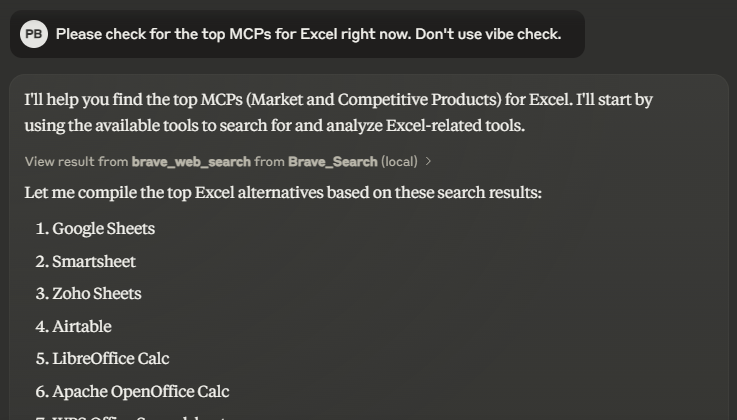pv_bhat_vibe_check_mcp_server
by PV-BhatVibe Check MCP Server for AI Workflow Oversight
 .jpeg)
.jpeg)
Overview
The Vibe Check MCP Server is a metacognitive oversight tool designed to prevent cascading errors in AI workflows. It introduces strategic pattern interrupts to ensure AI agents stay aligned with user intentions, avoiding over-engineering and scope creep. Built with LearnLM 1.5 Pro (Gemini API), it fine-tunes workflows for pedagogy and metacognition, ensuring AI agents don't get stuck in tunnel vision.
Key Features
- Pattern Interrupts: Breaks tunnel vision with metacognitive questioning.
- Plan Simplification: Encourages simplification of complex workflows.
- Self-Improving Feedback Loops: Logs mistakes to improve future decision-making.
The Problem: Pattern Inertia
AI agents often exhibit pattern inertia, where they continue down a reasoning path even when it’s clearly wrong. This leads to:
- Tunnel Vision: Stuck in one approach, unable to see alternatives.
- Scope Creep: Simple tasks evolve into enterprise-scale solutions.
- Overengineering: Adding unnecessary layers of abstraction.
- Misalignment: Solving a different problem than the one asked.
Tools for Metacognitive Oversight
🛑 vibe_check
A pattern interrupt mechanism that breaks tunnel vision with metacognitive questioning.
vibe_check({
"phase": "planning", // planning, implementation, or review
"userRequest": "...", // FULL original user request
"plan": "...", // Current plan or thinking
"confidence": 0.7 // Optional: 0-1 confidence level
})
⚓ vibe_distill
A meta-thinking anchor point that recalibrates complex workflows.
vibe_distill({
"plan": "...", // Detailed plan to simplify
"userRequest": "..." // FULL original user request
})
🔄 vibe_learn
A self-improving feedback loop that builds pattern recognition over time.
vibe_learn({
"mistake": "...", // One-sentence description of mistake
"category": "...", // From standard categories
"solution": "..." // How it was corrected
})
Installation & Setup
Installing via Smithery
Automatically install for Claude Desktop via Smithery:
npx -y @smithery/cli install @PV-Bhat/vibe-check-mcp-server --client claude
Manual Installation via npm
# Clone the repo
git clone https://github.com/PV-Bhat/vibe-check-mcp-server.git
cd vibe-check-mcp-server
# Install dependencies
npm install
# Build the project
npm run build
# Start the server
npm run start
Integration with Claude
Add to your claude_desktop_config.json:
"vibe-check": {
"command": "node",
"args": [\
"/path/to/vibe-check-mcp/build/index.js"\
],
"env": {
"GEMINI_API_KEY": "YOUR_GEMINI_API_KEY"
}
}
Environment Configuration
Create a .env file in the project root:
GEMINI_API_KEY=your_gemini_api_key_here
Agent Prompting Guide
Include these instructions in your system prompt:
As an autonomous agent, you will:
1. Treat vibe_check as a critical pattern interrupt mechanism
2. ALWAYS include the complete user request with each call
3. Specify the current phase (planning/implementation/review)
4. Use vibe_distill as a recalibration anchor when complexity increases
5. Build the feedback loop with vibe_learn to record resolved issues
When to Use Each Tool
| Tool | When to Use |
|---|---|
| 🛑 vibe_check | When your agent starts explaining blockchain fundamentals for a todo app |
| ⚓ vibe_distill | When your agent's plan has more nested bullet points than your entire tech spec |
| 🔄 vibe_learn | After you've manually steered your agent back from the complexity abyss |
API Reference
See the Technical Reference for complete API documentation.
Architecture
Vibe Check implements a dual-layer metacognitive architecture based on recursive oversight principles. Key insights:
1. Pattern Inertia Resistance: LLM agents naturally demonstrate a momentum-like property in their reasoning paths.
2. Phase-Resonant Interrupts: Metacognitive questioning must align with the agent's current phase.
3. Authority Structure Integration: Agents must treat external metacognitive feedback as high-priority interrupts.
4. Anchor Compression Mechanisms: Complex reasoning flows must be distilled into minimal anchor chains.
5. Recursive Feedback Loops: All observed missteps must be stored and leveraged to improve interrupt efficacy.
Documentation
| Document | Description |
|---|---|
| Agent Prompting Strategies | Detailed techniques for agent integration |
| Advanced Integration | Feedback chaining, confidence levels, and more |
| Technical Reference | Complete API documentation |
| Philosophy | The deeper AI alignment principles behind Vibe Check |
| Case Studies | Real-world examples of Vibe Check in action |
Contributing
We welcome contributions! Check out our Contributing Guidelines to get started.

